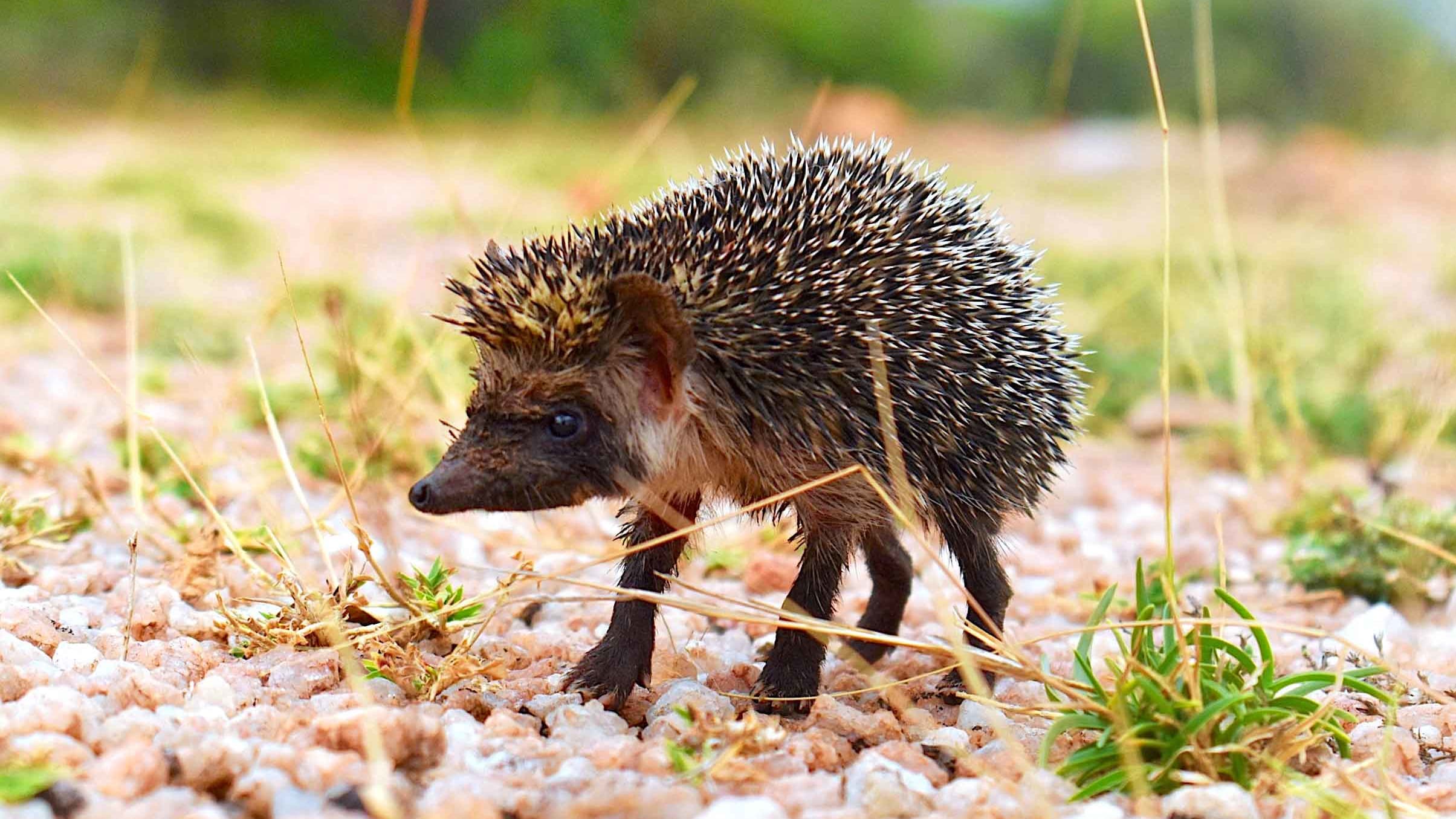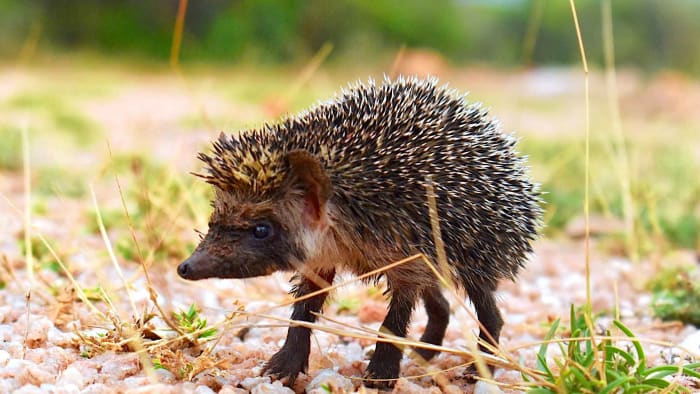 Listen to this article
•
15:34 min
Listen to this article
•
15:34 min
Tamil Nadu is famous for its temples, people, culture, and delicious food. But there is another undocumented and rarely explored side to this state. It is home to numerous endemic species, each one weaving its own unique story of survival. One such species is the Madras hedgehog (Paraechinus nudiventris). As wildlife biologists, we have long been captivated by the hedgehog and wonder about its unique adaptations. Brawin, in particular, has been studying and working to protect it for over a decade.
This small, nocturnal mammal, endemic to dry, arid regions and scrubby jungles in southeastern India, has fascinated us with its spiny defence mechanism, solitary nature, and nocturnal foraging habits. Determined to learn more about this elusive creature, we decided to venture to the place where the Madras hedgehog is known to thrive.
On a clear summer’s day in May 2023, with the help of local villagers, we had the opportunity to observe a Madras hedgehog for an entire day. The landscape had the ambience of a tropical savannah grasslands; shrubs and thorny trees dominated the rocky terrain, the branches of acacia trees reached out like umbrellas, and towering cacti stood silhouetted against the blue sky. Another notable insectivore primate that inhabits these thorny canopies is the slender loris (Loris lydekkerianus).

Cover photo: The bare-bellied or Madras hedgehog.
The Madras hedgehog (Family: Erinaceidae), also called bare-bellied hedgehog or South Indian hedgehog, is a little ball covered in a spiky armour, a superhero’s shield that protects it from predators. We wanted to observe and learn as much as possible about this rare creature by watching it closely as it went about its normal day. The hedgehog we met was a juvenile weighing about 100 grams and no more than 12 cm in length. Adults of this species grow to around 14-25 cm. Hedgehogs are generally creatures of the night, so it was very unusual to see this little one foraging during the day.
As an insectivore, the hedgehog forages for food hidden beneath leaf litter and rocks. This juvenile’s foraging behaviour consisted of continuously poking its nose under the leaf litter to pick out and eat insects. As it walked along, we saw a tiny tail, around 3 cm long, emerge. It was rather adept at finding food, almost as if it had its own secret mind map and knew exactly where to look. Its buffet was quite impressive. As an opportunistic predator, it nibbled on invertebrates like insects, worms, and snails. We watched the hedgehog snack on centipedes, each about as long as my finger. It also seemed to enjoy the centipede larvae it picked out of the soil.
While the Madras hedgehog navigated its way around, it left behind little drops of urine on the ground. A kind of secret message or communication to its friends, saying, “Hey, I was here!”.
As we observed the tiny creature, it yawned, paused its foraging, curled up, and took a nap. The nap lasted about 14 minutes, and then the hedgehog was up and about, ready to forage again. Much to our amazement, it repeated this pattern four times during the day. It followed an unhurried rhythm of yawn, nap, urinate, forage, nap, forage. We timed that its second nap lasted about 21 minutes. The hedgehog appeared well-adapted to its environment — it seemed to know the best hiding spots amid shrubs and napping spots in the crevices of rocks or on leaf litter.

In the daytime, when faced with what it thought could be a potential threat, it gracefully changed course and found its way into the dense shrubs. At night, it is the hedgehog’s sense of smell and hearing that helps it navigate through the dark.
When it felt threatened, the hedgehog curled into a tight ball, leaving only its little nose peeping out. It was a signal to its enemies to stay away while also being alert enough to sniff out danger. That coat of 2,000 spines isn’t just for show; it protects the animal from danger. After it feels safe again, it uncurls slowly, letting the nose and limbs out first to check for any threats before continuing on its way.
While the Madras hedgehog napped, it had some special visitors. Ants! They crawled all around it, but the hedgehog didn’t seem to mind. The ants wandered on its belly, climbed its spines, and even ventured up to its face. One ant appeared to bite the hedgehog’s nose. The hedgehog shuddered its head to dislodge the ant and went back to sleep.
Even while taking a nap, the hedgehog had its senses wide awake. It was alert to the tiniest sounds in the forest, the rustle of leaves, the harsh whisper of the wind, the snap of a twig.
We had started out on a nice sunny day, but the weather proved unpredictable. Around 5.45 pm, dark clouds appeared in the sky, and it started to pour. We knew we would soon have to pack up our gear and say goodbye to our spiky friend. To our surprise, the hedgehog seemed to love the rain and did not try to escape to a drier area. As the sun began to set, the hedgehog finally disappeared into the lush thorny bushes, and we wrapped up our observation.
Hedgehogs and ecosystems
In Tamil Nadu, grasslands and semi-arid areas are crucial to supporting diverse ecosystems. They provide essential resources for biodiversity and human communities. Yet, their value is often underappreciated due to a lack of awareness of their importance to numerous species. Habitat degradation from invasive plants, overgrazing, and urbanisation threaten these ecosystems, impacting their flora and fauna. Hedgehog populations suffer from shrinking habitats, road mortality (road kill), and predation. Scientific research helps to mitigate these threats by involving community engagement and habitat restoration to protect these unique species.
Sustainable land management, community engagement, and awareness campaigns are some conservation efforts required to protect the hedgehog’s environment. These steps are crucial to safeguarding the ecological and cultural significance of these grassland regions. As researchers, we want to learn more about these creatures and the nuances of their behaviour, habitat requirements, and how their populations shrink. It can help us predict future population trends, which are important for effective conservation management strategies. Collaborative efforts among researchers, policymakers and communities can ensure that this fascinating endemic creature remains and thrives as an enduring part of our biodiversity.









